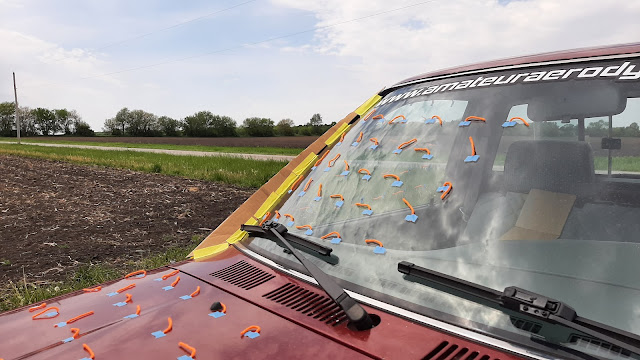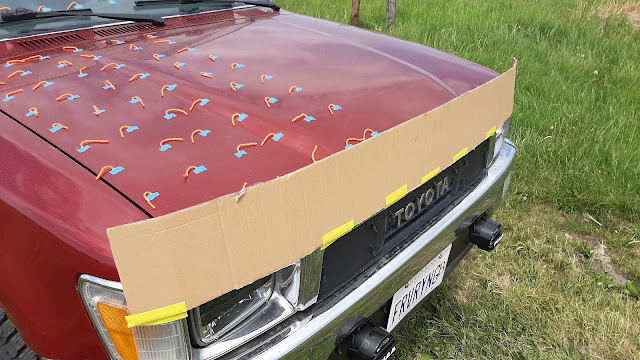In Part 1 of this series, I showed how to
use throttle-stop testing to a) get reliable measurements of changes in drag,
and b) how to use this measurement technique to test some simple modifications—blocking
the cooling air intake at the front of the truck and removing the side mirrors.
Together, those amounted to a 4% reduction in drag, so after the test was
completed I made permanent versions of both aerodynamic modifications:
Next up, we’ll look at one outlandish modification and one
typical change that a lot of pickup truck owners make.
Modifying A-Pillar Flow
When I go to auto shows, I take lots of pictures of details
on production cars. One of those fascinating details is the prevalence of what
I call “fenced” A-pillars; that is, the windshield is slightly inset below the
A-pillar and a sharp edge on the pillar stands proud of the glass:
 |
| Here's an example, on the 2019 Hyundai Elantra. |
My truck is an older design and doesn’t have this edge.
Instead, the windshield blends smoothly into a rounded A-pillar. What happens
if we change that to a more modern design?
There’s only one way to find out: test. No amount of
guessing will determine whether adding a permanent fenced A-pillar—which would
entail a large investment of time, design work, fabrication, and money for
materials—will be worth it. Could it reduce separation at the A-pillar?
Minimize flow to the side over the windshield? Or would it make the flow worse,
exacerbating the A-pillar vortex or increasing turbulence further back on the
window? How on earth would I know just by guessing at something so complex? So
to start, I spent five minutes mocking up a fence out of scrap cardboard that I
could tape to the pillar:
 |
| Look at that, three-dimensionally shaped and everything. Not bad for literally 5 minutes of my time. |
Then I taped tufts to the window and windshield and headed
out to my usual tuft-testing location, a 4-mile long, square route on the
University of Illinois’ South Campus.
Here’s the flow over the side window without and then with
the fenced A-pillar:
 |
| Top: no fence. Bottom: fence in place. |
 |
| Top: no fence. Bottom: fenced. |
 |
| Top: no fence. Bottom: fence. (For real this time). |
Bug Shields
Bug shields—small plastic pieces that advertisers claim send
bugs over your truck or SUV instead of splattering on the windshield—used to be
more popular. A quick Google search reveals that you can still buy them for
most current models and nearly all older trucks, but they just don’t seem to be
as common anymore. It used to be that bug shields were flat plates:
 |
| (Image source: f150forum.com) |
But now they are always molded plastic that conforms to the
shape of the hood and fenders:
 |
| (Image source: anchortruck.com) |
So, what do these do? Is there any truth to sellers’
claims? Again, the only way to find out is to test; an ounce of testing is
worth a pound of theorizing.
Using a slightly larger scrap of cardboard—left over from an
IKEA futon box—I cut out a quick approximation of a bug shield and taped it to
the front of the truck:
Then I taped tufts to the hood and drove it. Here’s the flow
over the hood and windshield without the shield:
Holy crap—something that I expected would have a minor
effect on the flow over the hood and none on the windshield turns out to be
disrupting flow over both surfaces, almost in their entirety! So yes—the claims
that bug shields can send insects over your truck instead of onto the
windshield may, in fact, have some truth to them. They may also be trashing the
flow over your truck’s front surfaces, so if you’re thinking of fitting one, test
it. My quick mockup is exaggerated in its height, so it may be that a
commercially-produced shield is better than this cardboard example—but may also
be worse at actually deflecting bugs.
There’s only one way to find out.






















Comments
Post a Comment